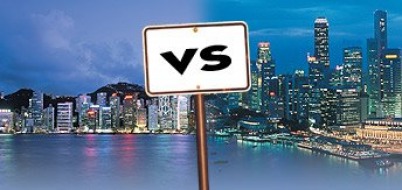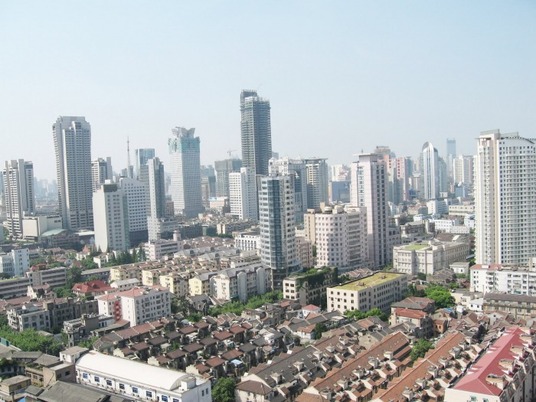|
Both Singapore and Hong Kong are tiny, densely populated , and yet so much full of life; Both of these cities are only three hours away from each by flight time other; are well connected with at least 25 daily flights each way; are home to two of the best International airlines in the world, Cathay Pacific Airways, and Singapore International Airlines; are chosen by many Multinationals as the Headquarters for their Asia Pacific Region operations; and both cities are the financial hubs for many banks and equity firms in the Asia Pacific Region.
For any new western business start up or any business leader, the question is almost always, will it be Singapore or Hong Kong? (Of course, the other major option people have is to set up in mainland China or in Hong Kong- but we'll discuss that some other time!). I personally believe, and I still stand to this point, that Singapore is somewhat like an “Asia for dummies”. My experience of living and working in both of these Asian cities as an expat has provided me with a privileged insight into their culture, lifestyle and general nature of doing business or travelling in these cities. Both are unique in their own ways. Hong Kong, with an area of around 1,105 km2 and a population of around 8 million, goes by the slogan "Asia's World City" because of its diverse mix cultures from all around the world. While Singapore, with an area of only 710.2 sq km and a population just under 5 million is equally diverse in terms of cultures, but more concentrated towards Asian cultures (Especially India, China and Malaysia). There are some people who may argue that it is indeed Singapore which should hold the title of "Asia's World City" because of its rich combination of Indian, Chinese and Malay population living side-by-side in harmony with each other. This argument is understandable when one observes that in Hong Kong you won't get a national holiday for Diwali (Hindu festival), Hari Raya (Islamic Festival), or even Vesak Day (Buddhist Festival); but in Singapore you will. I personally believe, and I still stand to this point, that Singapore is somewhat like an “Asia for dummies”. This is not a criticism about the country but rather an observation. Let me explain: If someone is flying from Europe to, say as an example, Australia or New Zealand, they are more than likely to stop over in either Hong Kong or Singapore (not discounting other Asian destinations of course). Now say that person has never been to other parts of Asia, and if Singapore is their first destination in Asia, they will get to experience some of the places of interests in Singapore, such as Little India, Arab Street and China Town (all of which have the strong ambiance of their respective cultures…so when you are in Little India- it actually feels as if you are in India and not Singapore, and so on). So it will give the visitors a taste of Asian cultures and cities. Singapore (or Singaporeans in general) actually thinks of itself as an island of modernity in a backward part of Asia. This may be true, but it is one of the most modern cities in Asia, and one of the fastest transformations that happened from being a developing country to a developed country all within a space of around 40 years. There are number of things which single out Singapore from Hong Kong. Singapore is one of the cleanest countries in the world (Chewing gum, smoking, spitting and shouting loudly are just some of the “habits” that are illegal in public places), plus the air is so much cleaner than in Hong Kong (sorry Hong Kongers…its true); its modern and its multi-cultural ambiance where, as an example, Malays happily celebrate Chinese and Indian festivals; and vice-versa. So if you ever want to experience true racial harmony, Singapore is the place for you! Equally well, there are a number of things which single out Hong Kong from Singapore, such as its vibrant fast pace and strong fusion of Chinese (Cantonese) and English cultures that you won’t see anywhere else in the world. Singapore's strong Chinese culture speaks Mandarin (like elsewhere in the world) with a Hokkien dialect (Fújiànhuà), unlike in Hong Kong where Cantonese is the primary language. If I was to pick out something unique about Hong Kong, it would most certainly be that Hong Kong seems to have an edge for the manufacturing industry because of its close proximity to China. Most foreign business persons also find the advantage of living in the “International” environment of Hong Kong while having their manufacturing base in Mainland China. There are a number of companies which have moved to Singapore because they see it being cheaper than Hong Kong, but the harsh reality is that Singapore is not a large country, so space is a big problem. On the whole both Singapore and Hong Kong are beautiful, diverse, full of rich culture, and energetic. If it came to a personal choice, I would say that Hong Kong is a great city to visit, do business in and explore; but it would be Singapore that I would choose to live in. This is because of two reasons: Less Pollution in Singapore (you are bound to see a clear blue sky in Singapore around 80% of the year according to my personal experience, but in Hong Kong that figure may be like 40% of the year); and Singapore is slightly cheaper than Hong Kong in terms of the cost of living. It comes down to personal choice. In terms of tourism, both Singapore and Hong Kong are incredibly great, and can easily be explored within three to four days (maybe a little longer for Hong Kong). I still miss those days when I used to commute on business between Singapore and Hong Kong on a regular basis. If there was a direct comparison between the two cities to those in the west, I would say that Singapore would the Los Angeles, while Hong Kong would resemble Manhattan, New York. Since 2008 Singapore has been one of the newest venues for the FORMULA 1, with the “SingTel Singapore Grand Prix” being heldat the new Marina Bay Street Circuit, and was also the first night-time event in Formula One history. It would be great fun to see if Hong Kong can also host the Formula 1 championship race. Punters would get the best of both cities. :-) It goes without saying that most Indian and Chinese people would not even explore the idea of integrating with each other’s cultures. It’s a historical thing, one which goes back to the early 19th century. Subhas Chandra Bose (1897-1945), an Indian nationalist leader, formed alliances with the Japanese during the second world war against the British and other oppressors of India, and even in Hong Kong, the Sikhs (who traditionally have been recruited into the Hong Kong Police or the armed forces) joined in with the Japanese forces. This alliance which the Indians (most of whom were Sikhs in Hong Kong and Shanghai at that time) made with the Japanese angered the local Cantonese people so much that since then there has always been a certain amount of sentiment between the Indian and Chinese communities in Hong Kong (and the rest of China for that matter)
One may question that these old thoughts may have been forgotten by the modern generation of Hong Kong people, however, according to Roger Houghton, a former Hong Kong police officer and British writer who has resided in the former British Colony for over 35 years says that these old sentiments get passed on from one generation to another. Even to the extent that sometimes Chinese elders discourage their grandchildren to make friends with Indian people. This may be a contributing factor, however, another factor is skin colour, and it is a well known fact that some Chinese people openly discriminate people of Indian origin (this is certainly true for some Cantonese people), and that includes every dark skinned person from the Middle East down to Burma, simply because these people have brown skin and smell of strong spices (of course, not everyone). There is reluctance amongst Hong Kong property owners to rent to Indians but that is more commercial than racial. Indian cuisine tends to penetrate the wallpaper and rugs and imbue the apartment with a spicy smell. When the Indian family leaves the residence, all these fittings have to be replaced. I believe it does not go any further than that. Nevertheless, Mr. Houghton explains that this attitude towards skin and smell were initially apparent in the first opium war. Also in Hong Kong, the sad fact is that the majority of Indians, Pakistanis and Nepalis do labor jobs, such as being doorman to hotels, or even the exceedingly annoying touting that goes around Tsim Sha Tsui doesn't really assist in improving their image much among Cantonese people. On the whole things are gradually changing for good, however say, even five years ago it would have been common practice on a Hong Kong MTR train that if the only empty seat on the train were next to a seated Indian person, then no Chinese person would dare sit on that seat, no matter how tired they may be. It’s an extreme example, but one that is based on facts (and from what I have seen with my own eyes). India and China were also at a brief war in 1962, and one of my late grandfathers’, who was a Commander in the Indian Army, fought against the Chinese in that war. I doubt history will repeat itself for both China and India cannot afford to make enemies with anyone in the current global economic and political climate. I still treasure a black & white photo of him standing along side a Chinese Army Captain on the Ladakh border station in the snowy terrain holding the Indian flag; likewise his counterpart is holding the Chinese flag. I am not sure what his thoughts would be now, if he knew that his grandson is actually encouraging foreigners to visit China for business and tourism! Indeed India and China, who share the world’s largest border (from Bhutan to the northern part of Kashmir), have been scratching each other’s backs for centuries over the border dispute. I remember my late grandfather used to tell me that since times in memorial, India has always been a close friend with Japan and Russia. I realized this as I grew up. But we must all accept that times are changing. Since 2005, India and China have held a number of joint Navy, Air Force and Army military exercises to boost friendship. I only started going to China in 2002 and at that time the world was just starting to realize that China (and India as well) is destined to become a strong economic threat to the west. Of course I was shocked to see how modern China was when I first went there. With those observations, I am always curious of what China may have looked like prior to the 1980s. I have met a number of former Red Army Soldiers and Government Party Officials who have told me that even today they are still very much proud to wear the traditional Mao suit and Mao Cap; and prior to the early 1980s there were hardly any advertising billboards, very few people had a television (and those that did were communist party members and the TV was only Black & White), there was no such thing as fashion because everyone wore the same dark blue suits, plus there were hardly any cars on the streets.
Of course, for those of us who have not experienced this lifestyle, it is very hard to believe all of this when you see all the technology in China these days. One thing I do fondly remember from the late 1990s, and this may be a sign of how things are changing, is that there was a surge of rich Chinese students from the mainland coming to study to the UK. Even when I graduated from Dulwich College in 1998, all of the Chinese borders were from Hong Kong; and compare that to, say, the present moment, where the vast majority of the Chinese borders studying at English Public Schools are from the mainland, not from Hong Kong. Even at British Universities, the number of Chinese (and Indian) students is rising as shown here. So, it’s now a well known fact that China and India are becoming rich (or Chinese and Indian people rather!), nevertheless, it’s always fascinating to known the real insight and viewpoint from someone who has seen the growth at first hand, right from the early 1920s to the present moment. Recently I had the honour of having lunch with the much respected Dr. Chan Cheng, who is the Hon. Director of Board of Trustees of Nanjing University, and the President of the China Re-unification Society, to celebrate the 60th Anniversary of the founding of the People's Republic of China. It was an inspiration to listen to his experience of what life in Shanghai was like in the 1930s and 1940s. And when you compare what he told me to what one may see on a 20 minute walk down in, say, Pudong, you immediately appreciate that we should not just take everything in modern China for granted, but to understand that there were those who fought hard for this success. Here is an e-mail which I received from Dr. Cheng, and with his kind permission I would like to share it. It perfectly sums up everything that we observe in 21st Century China. “ Dear Navjot Many thanks for your email and kind invitation. Here is my viewpoint: Shanghai was among several British and French concessions in China during the 1920s. As these were governed and occupied by foreign powers, the law served to protect foreign interests. The Chinese were second class citizens, seen as beneath the colonials. This was mainly due to an incompetent government. Today, Shanghai can be compared to a lion that has just woken up. It is a global financial centre brimming with sky scrapers. It is also the world's largest holder of foreign currencies. The Chinese government has been remarkably successful in guiding the country to global leadership status. This was most recently highlighted during the 2008 Beijing Olympics. Kind regards Chan Cheng |
Get in Touch:LIFE MATTERSHere I share my thoughts
and experiences during my travels, and how some things have affected my life as an expat and world traveller. Travelling is about capturing that moment in life. Every word, view and opinion on this page is that of Navjot Singh - except where indicated. The most recent is at the top. Scroll down to read the archive. Or search using CTRL+F (COMMAND + F) and enter a keyword to search the page. Just some of the stories you never heard before. The NAVJOT-SINGH.COM web blog is separate to this web site....Click blog, which may not be visible in some countries due to local firewall restrictions, so in those cases this weblog may be read. The weblog also includes some of my press trip reports- most of which are not published on the official blog because of copyright issues. The weblog also contains articles that may be associated directly with a PR trip for a country, airline or a hotel. These are PR reviews done in relations with various companies. If you are an investor or a trend watcher then you may find this website useful as investing has a lot to do with personal observations and finding the ideal trend or next big thing. The average human on the street frequently knows far more about the state of the economy than politicians, university professors, subject matter experts, and financial analysts who seldom travel, or if they do so, only from one hotel to another hotel! The pulse and vibrancy of an economy is nowhere more visible than on a country's streets. All photos and words are © Navjot Singh unless stated. Photos taken by others or by agencies are appropriately copyrighted under the respective name. No photo or word/s may be taken without the prior written permission by the author (i.e. Navjot Singh). All Rights Reserved. Archives
April 2024
Categories
All
|





 RSS Feed
RSS Feed







